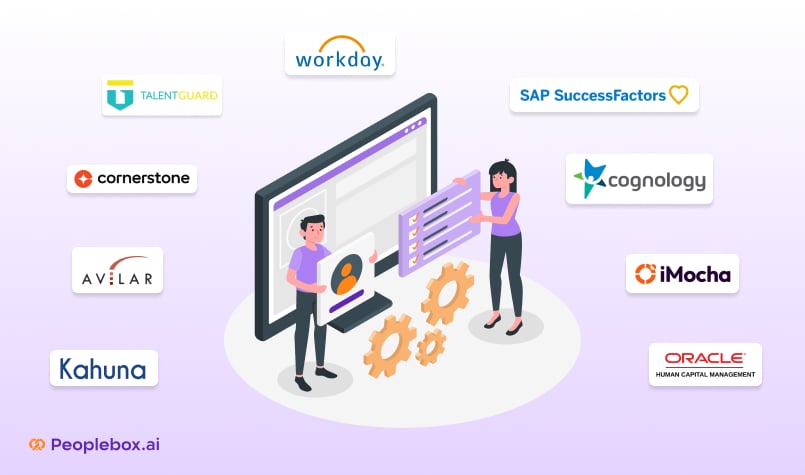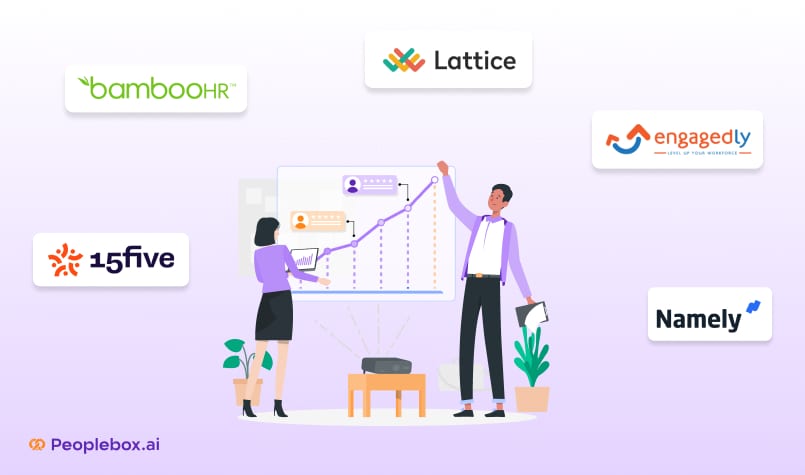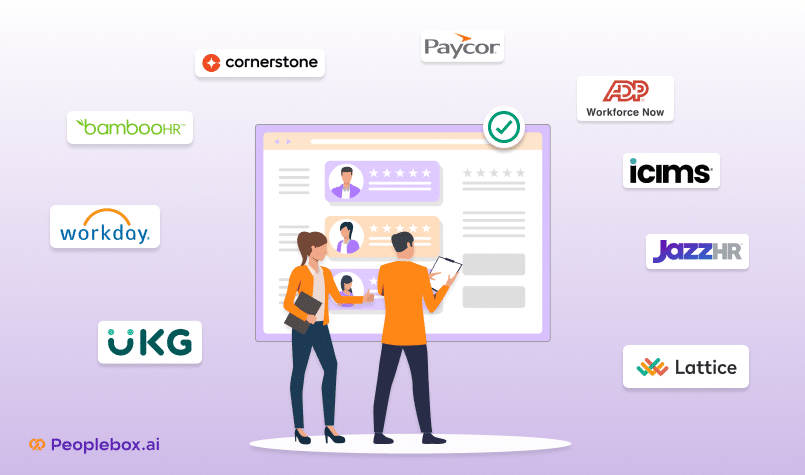Even after using all the usual hiring methods, you’re still struggling with unfilled jobs and fewer qualified candidates.
As an HR leader, you know hiring has changed a lot—candidates expect more, technology is moving fast, and business needs keep shifting.
According to a recent study, the average cost-per-hire is about $4,700.
But anecdotal data suggests that the total cost to hire a new employee can be even as high as three to four times the position’s salary.
New modern hiring methods can significantly reduce your costs. Using AI alone can save 20% of the cost.
The old methods aren’t just outdated; they’re ineffective.
You need new solutions that fit today’s world.
That’s why we’ve compiled a list of 9 modern hiring methods to help you face these challenges directly.
Using these strategies and Peoplebox’s AI Resume Screening tool, you can improve your hiring process, attract top talent, and stay ahead in the fast-changing job market.
What Is Modern Recruitment?
Modern recruitment refers to the innovative, new, and emerging strategies and practices organizations use to find, attract, and hire talent in today’s evolving job market.
In 2024, modern recruitment is a dynamic, data-driven, and highly candidate-centric process, characterized by the integration of advanced technology such as AI, a focus on diversity and inclusion, and an evolving understanding of the future workforce’s needs and values.
It also aligns with the changing business landscape, where organizations must adapt to shifting market demands, evolving skill requirements, and a greater emphasis on agility and innovation.
Key Changes Transforming Recruitment Today
Recruitment is changing in three main ways: what candidates expect, what businesses need, and how fast technology is improving.
Changing Candidate Needs
What people want from work has changed a lot.
Young people, like those from Generation Z, have different expectations of jobs.
The COVID-19 pandemic has also changed how we think about work.
Here’s what people are looking for:
1. Learning New Skills
Many workers want to keep learning.
More than one out of three people (37%) said in The Future of Recruiting Survey by PwC that they would take less money if they could learn new things at their job.
2. Candidate Experience
How a company treats job seekers matters a lot.
Nearly half (49%) of people looking for jobs in important fields like technology said in the same survey that they turned down a job offer because they had a bad experience during the hiring process.
3. Flexibility at Work
People want jobs that fit their lives.
Just over half (51%) would choose more flexibility over a higher salary. This is even higher for women (53%) and for people who have been working longer (56%).
4. Diversity and Inclusion
Many job seekers care about diversity.
About 62% said they are more likely to apply for a job if the company is openly working to improve diversity and inclusion.
Different Technologies Reshaping Recruitment
Technology is changing how companies hire people with technologies like AI, predictive analytics, and virtual reality.
1. AI
Gartner finds that by 2027, 80% of recruiting technology vendors will have embedded AI capabilities into their offerings. AI-enabled candidate matching—that is, finding and matching candidates quicker by scanning resumes and skills—is in particularly high demand.
For example, Peoplebox’s AI Resume Screening tool will automate the entire screening and shortlisting process. In a matter of seconds, it can accurately process thousands of applications.
It provides insights into each candidate’s strengths and weaknesses, including attributes from the public domain (LinkedIn, Crunchbase, PR, etc).
You get an instant score assigned to each candidate’s profile based on their skills and company fit. And that means you save time to hire and improve your hiring rate.
2. Predictive Analytics
Predictive analytics look at data to predict how well someone will do in a job.
3. AR/VR
AR/VR gives virtual job previews and lets candidates try tasks in a virtual setting.
These tools help businesses find, test, and connect with the right workers. Later, we will explain each of these technologies in more detail.
How AI and Data Will Transform the Recruiting Process
AI isn’t just about speeding up old processes—it’s expected to fundamentally change the job of HRs.
As AI will do a lot of mundane work, the focus for HRs will shift to more strategic and value-added tasks.
“Recruiting will no longer be purely about headcount, but about focusing on value-added tasks such as retention or DE&I policies,” says recruitment expert Hung Lee.
Changing Business Needs
Businesses today are facing new challenges that change how they hire people.
1. Rapidly Evolving Skill Requirements
The skills needed for many jobs are changing quickly because of new technology. Some skills become outdated quickly.
A survey of 3,500 managers showed that only 29% of new hires have all the skills needed for their jobs now, and even fewer for the future.
In important areas like finance, IT, and sales, research says workers will need up to 10 new skills in the next 18 months.
2. Outdated Traditional Talent Pools
In the past, companies often hired people straight out of college. Now, many people learn skills on their own through online courses or other ways.
So companies may be missing out on great talent like self-taught learners and remote workers if they stick to traditional local university hiring.
3. The Need for Agility in Recruitment
To manage the increasing pace of change in businesses, the recruitment function needs to be more agile.
About 75% of recruiting leaders say they need to be more agile now than they were three years ago.
And a part of that comes from adopting modern recruitment methods.
Top Modern Recruitment Methods
Below we’ll look at 9 recruiting methods aligned with today’s job market.
What Makes These Methods Modern?
These methods, techniques, or strategies take into account how things have changed recently to effectively attract and hire the right talent.
9 Modern Recruitment Methods
These methods address all three key trends: advancing technology, shifting candidate expectations, and evolving business needs.
By using these strategies, companies can stay competitive and hire the best workers in a fast-changing job market.

1. AI-Driven Recruiting
About 67% of HR professionals think that AI has many benefits and has a positive effect on the hiring process.
AI can help recruiters with many tasks they usually do, like:
- Creating interview notes
- Sourcing passive candidates
- Matching people to jobs based on their profiles
- Sending personalized messages to candidates
- Scanning resumes for important skills and words
- Using chatbots to pre-screen candidates, answer questions, and set up interviews
- Create job descriptions that are more inclusive and engaging by analyzing the language used and ensuring it’s free from gender or cultural biases
“All those things that took tons of time. [AI] can reduce the amount of effort required by orders of magnitude,” says recruitment expert Hung Lee.
📚Read more: Top 30 AI Tools for HR Teams
2. Immersive Experiences via Virtual Reality (VR)
Virtual Reality (VR) lets people enter a computer-made world that feels real.
With VR, companies can offer virtual tours of the workplace. Candidates can also try out job tasks in the virtual world, giving them hands-on experience before being hired.
This helps give a better idea of the job, keeps candidates engaged, and helps both the company and the candidate see if it’s a good fit.
3. Predictive Analytics via Integrated ATS
Modern Applicant Tracking Systems (ATS)—software applications used by recruiters and HR professionals to manage the recruitment process—often integrate with other software to bring together data from multiple sources.
According to the Recruitment Technology Trends Report 2024, integrated systems are key to better intelligence.
ATS can perform predictive analytics using integrated data.
Predictive models help decide if a candidate is a good fit, will stay at a job for a long time, and do well. These models look at things like:
- Job history
- Skills
- Personality traits
- Test results
- Industry trends
📚Read more: Retain Talent with Predictive HR Analytics
4. Third Spaces
Ray Oldenburg, a sociologist, coined “third places” to describe spots outside home (first place) and work (second place) where people connect with their community.
In recruitment, Hung Lee suggests using third spaces to engage talent.
He says: “The best way to do that is to create what I call a third space, which is not you invading their inbox or inviting them to someplace that you control.
“A third space that they can enter, like a pub or a bar… There’s no commitment if they turn up. They haven’t volunteered to be part of a recruiting process just because they turn up in your community.
You can’t just pipeline them in. They have that sense of agency and that sense of freedom. But they might just want to have conversations about a topic that you’re interested in.
“It’s not like dropping everyone into a CRM and doing a drip campaign to them. That’s just another version of spam.”
These third spaces can also be online communities and groups.
5. Employer Branding
As discussed above, candidates are becoming more selective and scrutinizing potential employers based on candidate experience, work-life balance, DEI, and upskilling opportunities.
“…your firm’s culture and the experience you provide people is your differentiated asset,” says Bhushan Sethi, Principal, Joint Global Leader, People and Organization, PwC US.
Here’s what companies can do to build a good employer reputation:
- Check your Reputation: See what employees say online about your company.
- Watch Group Opinions: Notice how different groups like women versus men or younger versus older workers view your company.
- Work with Leaders: Share findings and fix negative views.
- Learn Job Seekers’ Needs: Use focus groups to understand expectations and create attractive jobs.
- Focus on Upskilling: Highlight skill development in your employer brand.
- Great Management: Build a reputation for excellent leadership
6. Broaden Talent Pools
When competition for talent is fierce, it’s important to expand the kind of candidates you look for. Look beyond traditional sources like leading universities and colleges.
HBR recommends considering these non-traditional talent sources:
- Gig workers to accelerate time-to-market
- Current workers interested in lateral job transfers
- Hidden groups like neurodiverse or formerly incarcerated people
- Alumni with valuable institutional knowledge about your company
7. Skills-Based Hiring
Another way to expand your talent pool is by hiring for skills instead of traditional educational qualifications or work experience.
Now that people are learning skills outside of college and jobs through online courses and bootcamps, it’s important to focus on what people can do, not just their degrees.
Use skill tests and skill-based interview questions to see what candidates can do by asking them to complete relevant tasks or answer questions related to the job.
This helps you find people with the right abilities, even if they don’t have the usual qualifications.
8. Hire for Potential and Learning Ability
Technology changes fast, and jobs need new skills all the time. New workers might not have all the skills they will need in the future.
So, companies should look for people who are curious and good at learning. These people can pick up new skills as needed and adapt to changes.
Find people who learn quickly. They may not have all the skills now but can grow.
Look for people who have done different things and show that they learn fast or like learning. They might have:
- Taken courses
- Changed careers
- Started new hobbies
9. Digital Recruitment
According to a 2024 Gallup study, 50% of U.S. employees were recruited through online professional networking sites like LinkedIn, up from 39% in 2015.
While traditional methods like word of mouth and professional communities are still used, they aren’t as effective as digital recruiting.
These older methods offer a personal touch but are less likely to find employees who are thinking about leaving their jobs.
Conclusion
In a world where candidate expectations, technology, and business needs are constantly evolving, sticking to traditional recruitment methods just won’t cut it.
Adopting modern recruitment strategies is essential to attract and retain top talent.
By embracing AI and data, enhancing employer branding, broadening talent pools, and hiring for potential and learning ability, you can revolutionize your hiring process.
Don’t get left behind—take the first step towards modern recruitment with Peoplebox’s AI Resume Screening tool to automate the entire screening and shortlisting process, saving time to hire and improving your hiring rate.







